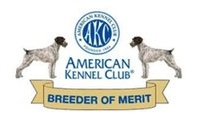GWP Breed Info
Welcome to the German Wirehaired Pointer (GWP) breed! The GWP was developed in Germany in the late 1800’s, where the breed is known as Drahthaar, the translation of Wirehair. They wanted a breed that could track, hunt and find game, point, and subsequently retrieve both wounded and dead game. It was necessary for the breed to be able to work on command in variable terrain, have unlimited stamina and be capable of retrieving boldly from water. It was also required to work with game birds, rabbit, fox, deer and wild boar – an all around versatile dog. The breed arrived in the US in the 1920s, then in 1959, they became recognized by the American Kennel Club.
The main characteristic of the GWP, which sets the breed apart from so many others, is the distinctive wiry coat. The breed is considered medium in size, with males slightly larger than the females. A fairly healthy breed, but the first time buyer should always inquire about health clearances of the sire and dam when looking for a puppy. Breeders should have no problem discussing or answering any health issues being asked. The following are considered the minimum to ask about: OFA or PennHip – hip dysplasia; Thyroid – congenital thyroid disease (gwp’s are ranked #11 most common breed affected); Cardiac – echocardiogram for congenital cardiac; OFA or CERF eye clearance. Read more about health clearances.
It is important to remember this is primarily a hunting dog, bred for a purpose, and needs to be able to channel that energy, or they will easily bore if lacking attention needed to stimulate the mind. GWP’s are sensitive and do not take well to harsh correction. The breed is also prone to stubbornness, but this is generally because the necessary basic discipline has been neglected or there is confusion over what the owner or handler requires. The breed is known to have a “switch”; on in the field, off in the house. GWP’s are naturally very intelligent and are eager to please. They make excellent companions for people who want to spend time with their dogs because of the alert and affectionate nature of GWP’s, but they do not make good kennel dogs because of a strong desire to be included in all activities. GWP’s are extremely devoted to and protective of the owner and family.
The GWP has an outer coat which is thick, harsh, completely covering the body, close fitting, and of a reasonable length, usually not longer than one and a half inches. Underneath the top layer is a dense softer undercoat which helps to protect and insulate. The eyebrows are bushy, and the muzzle must have a full but not over-long beard.





